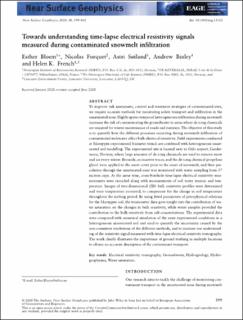| dc.description.abstract | To improve risk assessment, control and treatment strategies of contaminated sites, we require accurate methods for monitoring solute transport and infiltration in the unsaturated zone. Highly spatio‐temporal heterogeneous infiltration during snowmelt increases the risk of contaminating the groundwater in areas where de‐icing chemicals are required for winter maintenance of roads and runways. The objective of this study is to quantify how the different processes occurring during snowmelt infiltration of contaminated meltwater affect bulk electrical resistivity. Field experiments conducted at Moreppen experimental lysimeter trench are combined with heterogeneous unsaturated soil modelling. The experimental site is located next to Oslo airport, Gardermoen, Norway, where large amounts of de‐icing chemicals are used to remove snow and ice every winter. Bromide, an inactive tracer, and the de‐icing chemical propylene glycol were applied to the snow cover prior to the onset of snowmelt, and their percolation through the unsaturated zone was monitored with water sampling from 37 suction cups. At the same time, cross‐borehole time‐lapse electrical resistivity measurements were recorded along with measurements of soil water tension and temperature. Images of two‐dimensional (2D) bulk resistivity profiles were determined and were temperature corrected, to compensate for the change in soil temperature throughout the melting period. By using fitted parameters of petrophysical relations for the Moreppen soil, the tensiometer data gave insight into the contribution of water saturation on the changes in bulk resistivity, while water samples provided the contribution to the bulk resistivity from salt concentrations. The experimental data were compared with numerical simulation of the same experimental conditions in a heterogeneous unsaturated soil and used to quantify the uncertainty caused by the non‐consistent resolutions of the different methods, and to increase our understanding of the resistivity signal measured with time‐lapse electrical resistivity tomography. The work clearly illustrates the importance of ground truthing in multiple locations to obtain an accurate description of the contaminant transport. | en_US |

